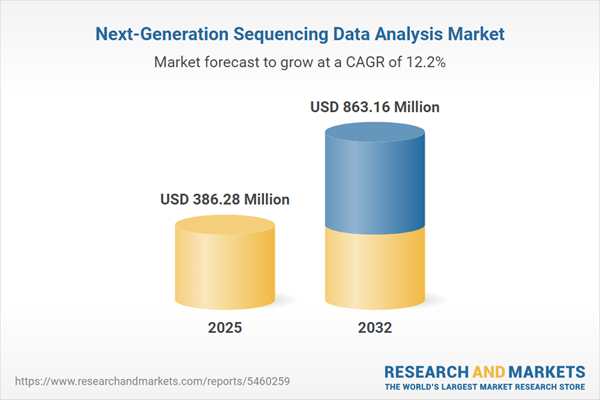Speak directly to the analyst to clarify any post sales queries you may have.
The next-generation sequencing data analysis market is rapidly reshaping how life sciences and healthcare organizations unlock genomic insights. Senior decision-makers will find this market undergoing significant advances and facing new pressures that demand agile adaptation, robust infrastructure, and integrated bioinformatics solutions to maximize value from sequencing investments.
Market Snapshot: Next-Generation Sequencing Data Analysis Market Growth
The next-generation sequencing data analysis market grew from USD 343.85 million in 2024 to USD 386.28 million in 2025 and is projected to reach USD 863.16 million by 2032, at a CAGR of 12.19%. Growth drivers include technological advances in sequencing platforms, rapid expansion of clinical and research applications, and increased adoption of cloud-based workflows among global research and healthcare organizations.
Scope & Segmentation of the Market
This report delivers an in-depth analysis of all major segments and their relevance to the next-generation sequencing data analysis market. Key segmentation lines are:
- Product Types: Consumables and reagents (including flow cells, library prep kits, and specialized reagents), instruments (benchtop and high-throughput sequencers), and services (data analysis and sample preparation).
- Applications: Epigenomics, genomics (such as targeted sequencing and whole genome sequencing), metagenomics, personalized medicine (including cancer diagnostics and pharmacogenomics), and transcriptomics approaches.
- End Users: Academic research entities, clinical diagnostics laboratories, contract research organizations, hospitals and clinics, and pharmaceutical and biotechnology companies.
- Regional Coverage: Americas (including North and Latin America), Europe, Middle East & Africa, and Asia-Pacific—each with their respective key countries and emerging hubs.
The study further evaluates recent trends shaping sequencing technologies, including the maturation of single-cell and spatial protocols, growth of AI-driven analytics, and increasing focus on data interoperability standards.
Key Takeaways for Senior Decision-Makers
- High-throughput and benchtop sequencing innovations are reducing turnaround times and granting access to advanced data analysis for organizations of varying size and focus.
- Integrated informatics pipelines leveraging artificial intelligence, machine learning, and cloud-native platforms are driving accuracy and efficiency in variant interpretation and predictive modeling.
- The ability to handle and integrate diverse datasets—such as epigenomic profiles, single-cell reads, and multi-omic signatures—is expanding the practicality of sequencing beyond basic research into diagnostics and population health.
- Supply chain resilience is increasingly crucial, as organizations face complexity in sourcing key reagents and equipment. Diversified supplier networks and strategic alliances now underpin successful operations across markets.
- Collaboration between instrument manufacturers, software developers, and cloud service providers is facilitating end-to-end solutions and supporting more scalable, collaborative research and clinical workflows.
- Rapid regional adoption is seen in Asia-Pacific, while Americas and EMEA markets emphasize integration into precision medicine, public health initiatives, and regulatory compliance.
Tariff Impact: Navigating Regulatory and Supply Chain Challenges
United States tariff changes in 2025 introduced complexity into global sequencing reagent and instrument procurement. Organizations adapted by strengthening inventory management, diversifying supplier portfolios, and fostering local manufacturing and co-development arrangements to buffer cost pressures and delivery delays. These measures are increasingly foundational to operational agility and continuity in sequencing data analysis workflows.
Methodology & Data Sources
This research utilizes a rigorous multi-layered method, synthesizing peer-reviewed literature, regulatory documents, industry reports, and primary interviews with technology vendors and expert end-users. Insights are carefully validated through cross-referencing, scenario modeling, and expert review panels to provide decision-drivers that reflect both broad industry trends and practical operational realities.
Why This Report Matters in Next-Generation Sequencing Data Analysis
- Offers comprehensive segmentation and industry trends for informed investment and planning decisions.
- Equips stakeholders with actionable strategies to address both technology adoption and supply chain risks in a dynamic regulatory landscape.
- Enables identification of partnership and innovation opportunities across regions, product types, and user segments.
Conclusion
Advancements in next-generation sequencing data analysis continue to open new possibilities in research, diagnostics, and population health. Organizations that adapt through integrated analytics, supply chain resilience, and targeted expertise development will be positioned to lead in this evolving market landscape.
Additional Product Information:
- Purchase of this report includes 1 year online access with quarterly updates.
- This report can be updated on request. Please contact our Customer Experience team using the Ask a Question widget on our website.
Table of Contents
3. Executive Summary
4. Market Overview
7. Cumulative Impact of Artificial Intelligence 2025
List of Figures
Samples

LOADING...
Companies Mentioned
The key companies profiled in this Next-Generation Sequencing Data Analysis market report include:- Illumina, Inc.
- Thermo Fisher Scientific Inc.
- QIAGEN N.V.
- F. Hoffmann-La Roche Ltd
- Agilent Technologies, Inc.
- BGI Genomics Co., Ltd
- PerkinElmer, Inc.
- Bio-Rad Laboratories, Inc.
- DNAnexus, Inc.
- Seven Bridges Genomics, Inc.
Table Information
| Report Attribute | Details |
|---|---|
| No. of Pages | 191 |
| Published | October 2025 |
| Forecast Period | 2025 - 2032 |
| Estimated Market Value ( USD | $ 386.28 Million |
| Forecasted Market Value ( USD | $ 863.16 Million |
| Compound Annual Growth Rate | 12.1% |
| Regions Covered | Global |
| No. of Companies Mentioned | 11 |









